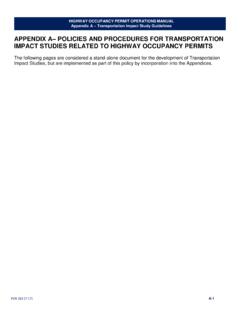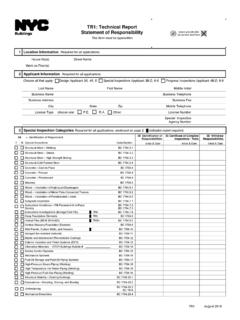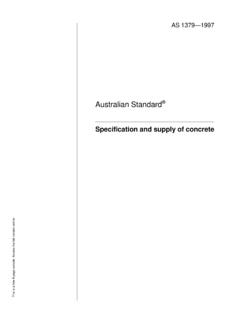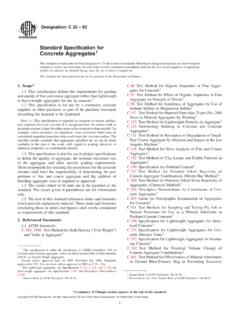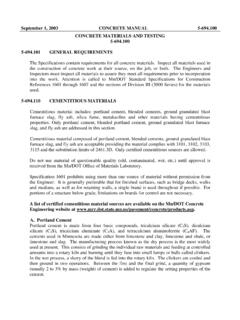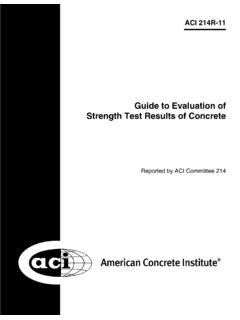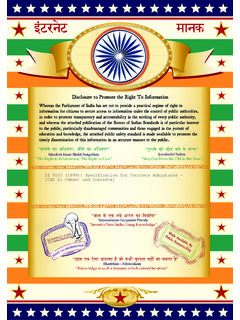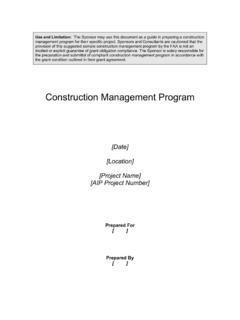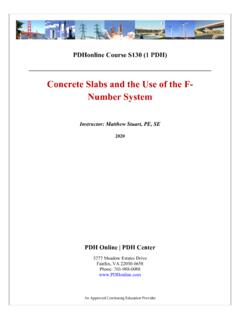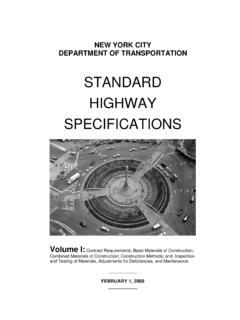Transcription of Code and Standards Requirements For Acceptance Testing
1 Code and Standards Requirements For Acceptance TestingPhilip KresgeVice-President, Local PavingNational Ready Mixed concrete AssociationWWW. presentation has been prepared solely for information purposes. It is intended solely for the use of professional personnel, competent to evaluate the significance and limitations of its content, and who will accept full responsibility for the application of the material it contains. The National Ready Mixed concrete Association and any other organizations cooperating in the preparation of this presentation strive for accuracy but disclaim any and all responsibility for application of the stated principles or for the accuracy of the content or sources and shall not be liable for any loss or damage arising from reliance on or use of any content or principles contained in this presentation. Unless otherwise indicated, all materials in this presentation are copyrighted to the National Ready Mixed concrete Association.
2 All rights reserved. Therefore reproduction, modification or retransmission in any form is strictly prohibited without the prior written permission of the National Ready Mixed concrete Association. 2018 National Ready Mixed concrete of Acceptance Testing concrete supplied complies with specification sampling and Testing should comply with Standards 1 sample represents 10 cubic OR 150 cubic yards (depending on frequency) Improper procedures generate inaccurate results Will cost someone Will delay projectWWW. of Testing Samples obtained in accordance with ASTM C172 Point of delivery from transportation unit (or mixer) Other sampling methods should be defined Fresh concrete tests Slump or slump flow tolerances in ASTM C94; ACI 117 Air content tolerance Temperature limits in specifications Density typically no limits unless its lightweight concrete Strength specimens Average of two 6x12 in or three 4x8 in cylindrical specimens Standard cured in accordance with ASTM C31 Tested in accordance with ASTM C39 at 28 days or as per specWWW.
3 Curing Curing Removal of forms or shoring Minimum strength for post-tensioning Determine if structure can be put into service Adequacy of curing and protection Compare with standardcured or with other in-place tests Quality control Developing mixture proportions for strengthrequirements Acceptance Testing forspecified strengthWWW. Strength Acceptance CriteriaTest results - Should meet both criteria 1. Average of 3 consecutive c 2. Single test ( c 500) For c> 5000 psi Single test cProbability of failure < 1 in 100 (1%)WWW. 318-14 for Low Strength Results Avg 3 consecutive - less than c Increase strength level Single test - less than ( c- 500) Increase strength level Investigate low strength - structural safety Reduced load carrying capacity of structure confirmed by calculations Core tests7 WWW. Cured Cylinders For evaluating protection and curing of structure (ACI 318) Acceptable if field cured > 85% of companion lab curedOr > ( c+ 500) psi Also used for formwork removal, post-tensioning8 WWW.
4 For LaboratoriesACI 318 ACI 3019 WWW. AssuranceTesting Lab conducting QA Testing Conformance to ASTM C1077 Inspected Accredited Technicians Certified Field Testing Strength Testing Lab Testing Testing in accordance with ASTM or AASHTO Timely distribution of test reports to all parties10 WWW. ASTM C1077 Quality System Written manual Under direction of PE Personnel evaluation Equipment calibration Inventory control Participation in proficiency sample program Laboratory inspection and accreditationWWW. Affecting StrengthWWW. violations - TestingReason (Average strength reduction) Initial curing (30%) Damaging green specimens (18%) Filling in one layer (17%) From chute / no tapping (12%) Top etching / no lids (11%)Adapted from SnellWWW. violations - TestingWWW. of concreteACI 318 Section Test SpecimensStandard Curing - ASTM C31 Maintain moisture Initial temperature in field 60 F to 80 F c> 6000 psi - 68 F to 78 F Transport to lab within 48 hrs Transportation time 4 hrs or less Lab curing F and moistWWW.
5 C31 Note 8 Standard CuringSatisfactory moisture environment Immerse in water Store in wooden boxes or structures Place in damp sand Cover with removable lids Place inside plastic bags Cover with plastic sheets or plates with damp burlapWWW. C31 Note 8 Standard CuringSatisfactory temperature environment Use of ventilation Use of ice Thermostatically controlled heating or cooling Heat, such as stoves or light bulbs Immersion in water may be easiest to control temperatureWWW. of standard proceduresInitial Curing is most frequent problemWWW. ObservationProperly stored in initial curing environment 1/3 of timeWWW. Curing OptionsWWW. SandWWW. in Water/CoolersAdd water (use ice if needed) and insert hi-low thermometerWWW. ControlledWWW. of Initial CuringHot WeatherSeries D338 concrete Strength - Hot Weather Exposure01000200030004000500060000102030 405060708090 Age, daysCompressive Strength, psi606570758085 Avg.
6 Daily Temp, FStandard Curing48h out - moistOutsideAvg daily tempWWW. of Initial Curing Cold Weather010002000300040005000600001020304 05060708090 Age, daysC o m p re s s iv e S tre n g th , p s i102540557085A v g . D a ily T e m p , FStandard Curing48h out - moistOutsideAvg daily temp32 FWWW. of Initial CuringImportance of temperature and duration of initial curing on 28-day compressive strengthInitial Curing (days)Relative StrengthInitial Curing Temp37 F73 F100 FMoist cured100% (5590 psi)1100%92%88%393%89%78%1489%78%67%2873 %73%62%NRMCA Pub 53; Delmar L. Bloem,1954 WWW. of Initial CuringImportance of temperature andmoisture during first 24 hours of initial curing on 28-day compressive strengthCondition (1 day initial curing)Temp RangeRelative strengthJobsite* Curing box; in water71 - 76 F100%Lab immersed in water73 - 82 F100%Lab in air78 - 82 F88%Jobsite* not protected71 - 107 F85%Jobsite* covered with wet burlap94 - 135 F83%4860 psi* Cylinders were kept exposed to sunlight; thermometer shieldedData from F.
7 Kozeliski New Mexico, 2016 WWW. of Initial CuringInitial curing for 24 hours - Within limits of ASTM C31 ConditionRelative Strength (28-day)Cement ACement B60 F in water100% (6080 psi)100% (6090 psi)60 F in air92%97%80 F in water89%93%80 F in air81%88%NRMCA study: Meininger, ASTM Cement concrete & Aggregates, 1983 Average Effect:Water vs. Air+ F vs. 80 F+ F water vs. 80 F air+16%Both temperature limits and moisture provision matterWWW. C31 ReportWWW. in Laboratory ReportsWWW. for TestingACI 301 WWW. for TestingACI 301 WWW. for TestingWWW. of a Test Report Reporting Requirements of C31 and C39 Dates pour, cylinders made, rec d at lab Ambient / concrete temperature Slump, air content, density Duration of initial curing Min / max temperatures Curing method 7 & 28 day strengths Strength gain35 WWW. Hardened CylindersVariables: Timing Up to 48 hrs, or 8 hrs after final set Duration of Travel 4 hours Proper Cushioning Protect from Freezing Protect from Moisture LossWWW.
8 Test ResultsWhat do Standards Say Responsibilities Reporting Data evaluation Precision Rating test resultsWWW. variability (ACI 214R) Within-batch coefficient of Variation (V1) Average range ( ) from10 tests = Average strengthNo. Calculation of V1 Cylinder 1, psiCylinder 2, psi Strength Test Result, psi Range, psi 6740 7120 6930 380 7050 6750 6900 300 5640 5830 5735 190 5570 5550 5560 206030 5700 5865 330 5690 5650 5670 405530 5600 5565 705350 5320 5335 304650 5080 4865 430 5800 6080 5940 280 Average5837 207 psi =VWWW. precisionQuality Standards (ACI 214) Excellent Very GoodGoodFairPoorV1, %< to to to > Range of 2 Companion Cylinders(assuming avg. 4800 psi)< 162 162 to 217 217 to 271 271 to 325 > 325 V1> 6% - reason to question Testing V1between 4 and 6% - potential problems V1 between 2 and 3% - C39 Testing variation < - likely too good to be trueWWW. C39 Single Operator precision Companion cylinders tested at same age Acceptable range should not be exceeded more often than 1 time in 20 WWW.
9 Calculation within-batch RangeCylinder 1, psi Cylinder 2, psi Test Result, psi Range, psiRange, %6740 7120 6930 380 6750 6900 300 5830 5735 190 5550 5560 20 5700 5865 330 5650 5670 40 5600 5565 70 5320 5335 30 5080 4865 430 6080 5940 280 207 WWW. Calculation - within batch 1 Cylinder 2 Test ResultWithin-batch rangeWithin-batch range, %Moving Average of 10 TestsMoving average of 10 RangesMoving 10 test V1, % ( )= Charts to Monitor Testing0%5%10%15%20%25%051015202530 Within-batch RangeSample Number2%3%4%5%6%7%8%9%10%051015202530 Within-batch Coefficient of VariationSample NumberExcellentVery goodGoodFairPoorWWW. Strength Data Poor job site curing will reduce strength But may not reflect within batch variation, V1 WWW. C39 Multi-lab precision COV = 5% Acceptable difference between 2 = 14% Useful for companion Testing Same sample tested by 2 labs at same age Split samples (same wheelbarrow or same load)WWW.
10 Tests300040005000600070008000 Mar-13 Apr-13 May-13 Jun-13 Jul-13 Aug-13 Compressive Strength, psiDateCompanion Strength Test DataTest LabCompanyLab AvgComp AvgCompany Data at plant; Lab data at jobsiteSpecimens from the same sample are better to evaluate for multi-lab precisionWWW. of Good TestingStrength Standard Deviation (variability) Materials Production Testing Components of variation are cumulativeReducing Testing Variation helps isolate other causes of variation that the producer can controlWWW. if you have Low Test Results? NRMCA Pub 133 Confirm likelihood of low strength Verify Testing accuracy Non destructive tests Structural capacity reduced (Engineer decision)? Core tests Load tests Corrective measuresEstablish responsibility (monetary) for low strength evaluations (pre-construction)WWW. concrete CoresACI 318 criteria: Average of 3 cores c Individual core cWWW. ACI Standards (Code and Specification) Defines Acceptance criteria for strength test results Laboratories should conform to ASTM C1077 Technicians in the field and lab should be certified Initial curing in accordance with ASTM C31 Max-min temps and curing method must be recorded (and reported) Test reports should be distributed to all stakeholders Criteria for core tests are defined Testing variation is high when V1>4% (from last 10 data points) Range >8% (or C39) more than 1-in-20 Responsibility for low strength evaluation should be definedWWW.
